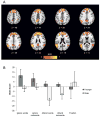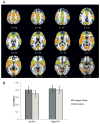Age differences in the frontoparietal cognitive control network: implications for distractibility
- PMID: 22659108
- PMCID: PMC4898951
- DOI: 10.1016/j.neuropsychologia.2012.05.025
Age differences in the frontoparietal cognitive control network: implications for distractibility
Abstract
Current evidence suggests that older adults have reduced suppression of, and greater implicit memory for, distracting stimuli, due to age-related declines in frontal-based control mechanisms. In this study, we used fMRI to examine age differences in the neural underpinnings of attentional control and their relationship to differences in distractibility and subsequent memory for distraction. Older and younger adults were shown a rapid stream of words or nonwords superimposed on objects and performed a 1-back task on either the letters or the objects, while ignoring the other modality. Older adults were more distracted than younger adults by the overlapping words during the 1-back task, and they subsequently showed more priming for these words on an implicit memory task. A multivariate analysis of the imaging data revealed a set of regions, including the rostral PFC and inferior parietal cortex, that younger adults activated to a greater extent than older adults during the ignore-words condition, and activity in this set of regions was negatively correlated with priming for the distracting words. Functional connectivity analyses using right and left rostral PFC seeds revealed a network of putative control regions, including bilateral parietal cortex, connected to the frontal seeds at rest. Older adults showed reduced functional connectivity within this frontoparietal network, suggesting that their greater distractibility may be due to decreased activity and coherence within a cognitive control network that normally acts to reduce interference from distraction.
Copyright © 2012 Elsevier Ltd. All rights reserved.
Figures








References
-
- Alain C, Woods DL. Age-related changes in processing auditory stimuli during visual attention: Evidence for deficits in inhibitory control and sensory memory. Psychology and Aging. 1999;14:507–519. - PubMed
-
- Badre D. Cognitive control, hierarchy, and the rostro-caudal organization of the frontal lobes. Trends in Cognitive Sciences. 2008;12:193–200. - PubMed
-
- Buckner RL, Andrews-Hanna JR, Schacter DL. The brain’s default network: anatomy, function, and relevance to disease. Annals of the New York Academy of Sciences. 2008;1124:1–38. - PubMed
Publication types
MeSH terms
Grants and funding
LinkOut - more resources
Full Text Sources
Medical
Miscellaneous

